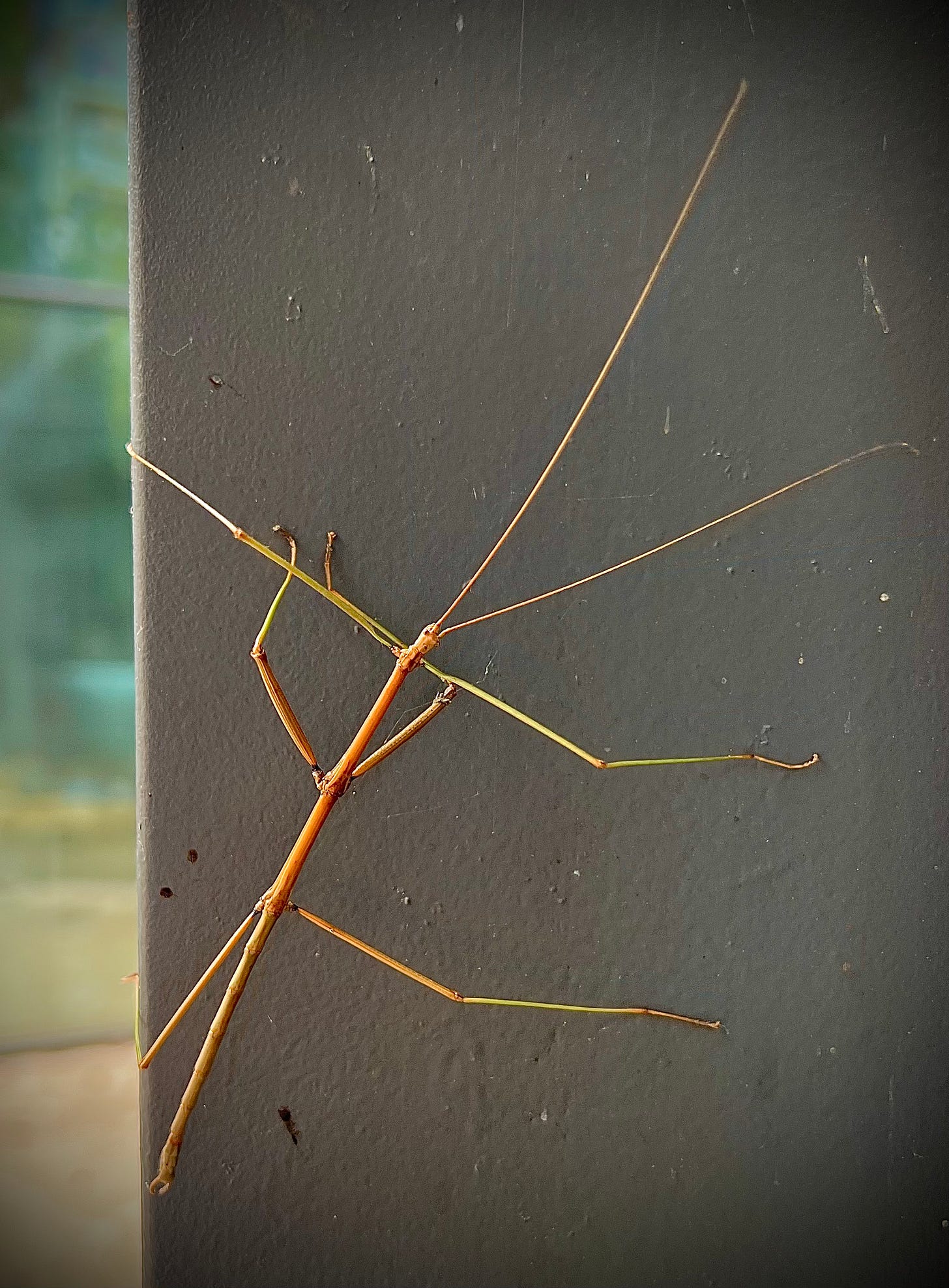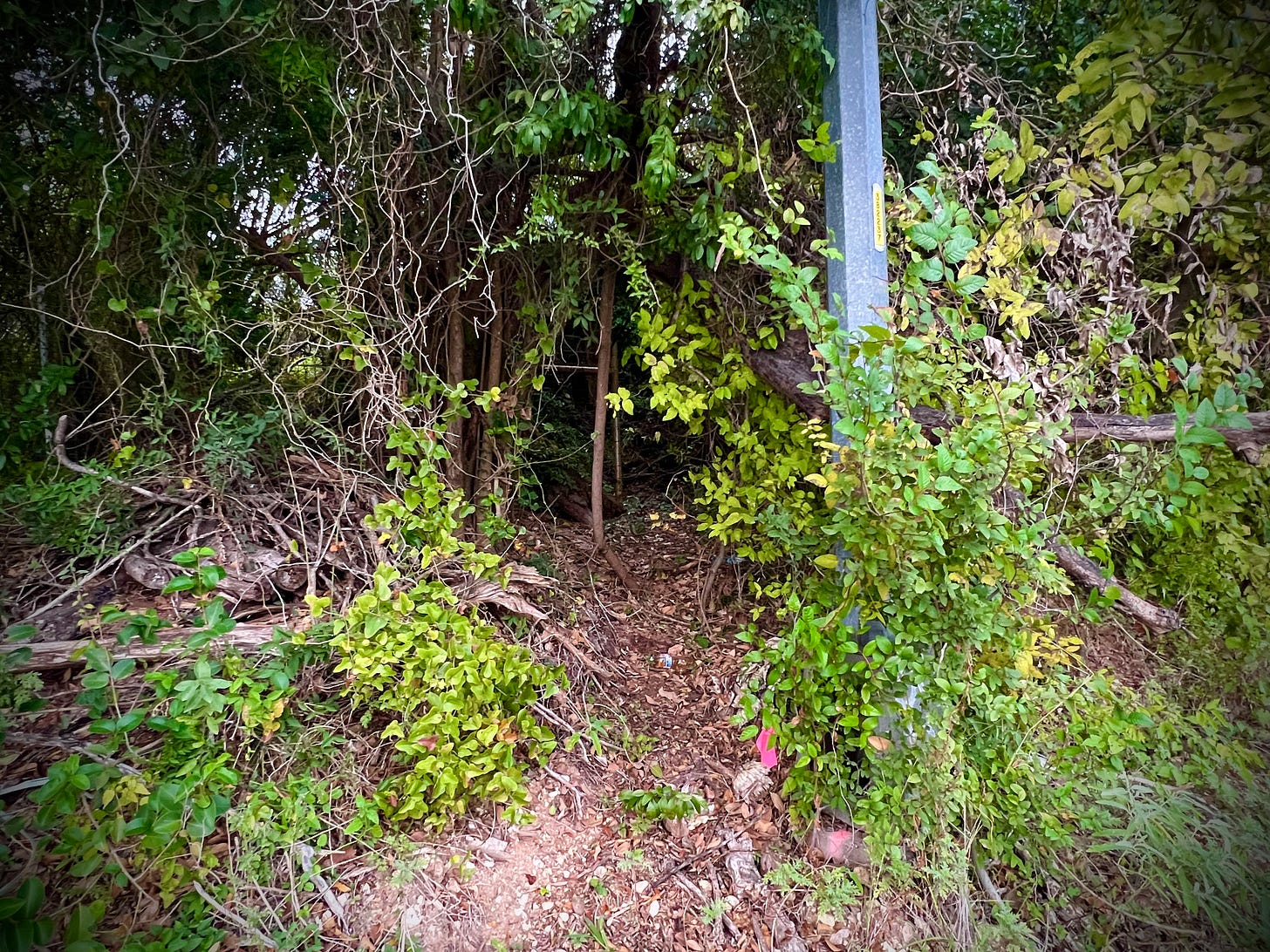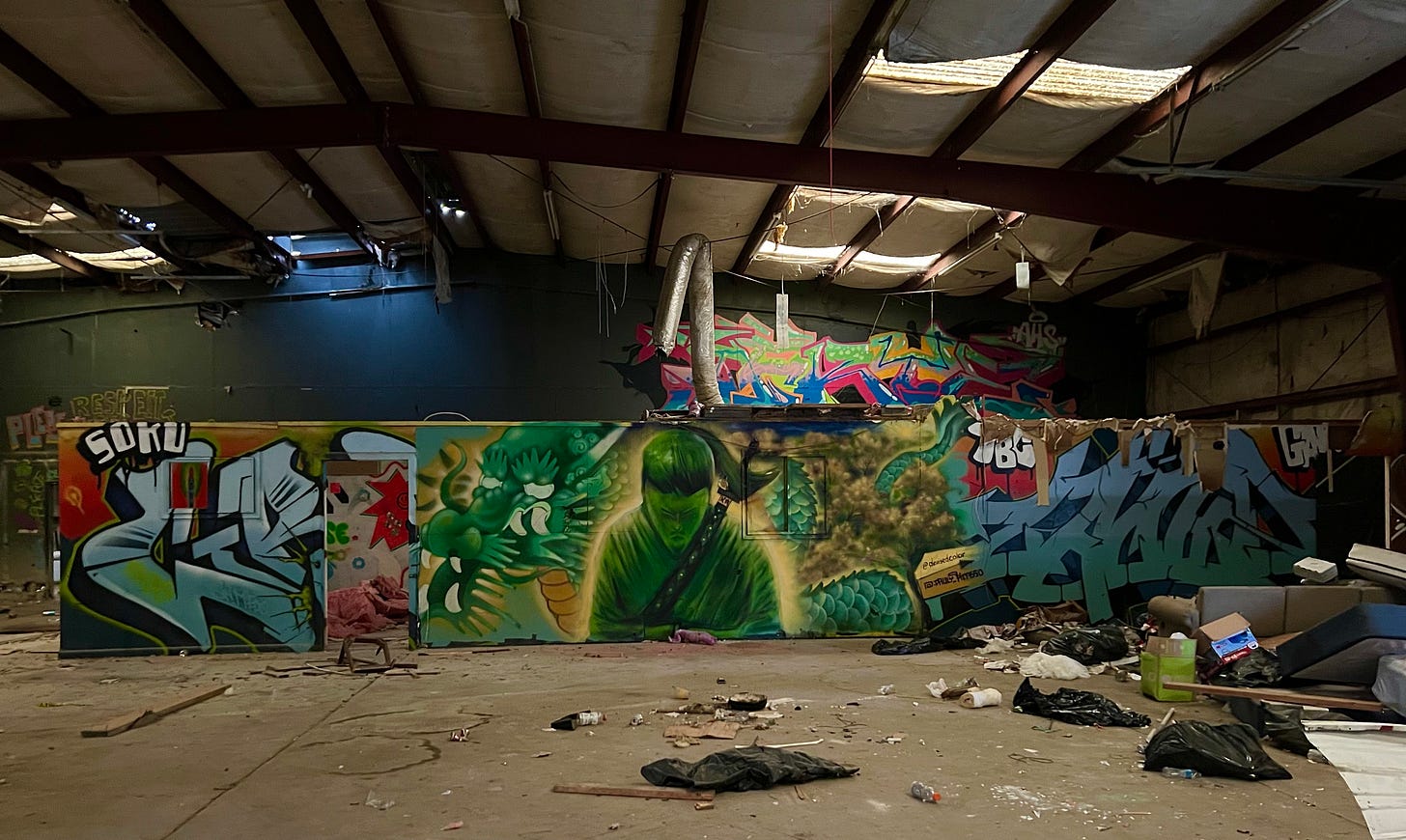Autumn Blooms in the Astronaut Squat
Halloween brought sustained rain to Central Texas after a long, brutally dry summer, and this week you could see the results. The rain lilies that had appeared overnight at the base of the onramp were already gone, but less ephemeral life began to appear—the signs of spring that you always get at the beginning of winter here in a region with two growing seasons. The spiderwort is the first, along the shady edge of the bluff behind the factories, between and sometimes on the big chunks of busted-up curb cuts and building foundations that got illegally dumped here back in the day. It will be the first to bloom come February, even if its green blades get a little frostbite.
Along the fenceline halfway down the bluff, where I went two nights in a row this week to block holes our dog’s visiting canine Houdini sister had dug to find her way back home, I found a bountiful bunch of bushes of chile piquín that have not yet been discovered by the birds, just when I thought we would end the season with none. Out on the street, the inland sea oats are already appearing in the abandoned basketball court across from the bus depot. And along the driveway of the new motor oil distribution center, the powderpuff mimosa is in bloom, with tiny hot pink pom poms the size of a grasshopper’s head that terminate in little drips of gold. A wonder so tiny, and covering such a minuscule patch of earth, you can be sure almost no one sees it. They always make me think of that trippy Captain Beefheart song about Kandy Korn: “They look so good, I wanna eat ‘em.”
In the sheltered glass and steel canyon of our patio, underneath our suddenly lush green roof, the lady walking sticks are lazing about the shortened days, perhaps waiting for the less common males of their species to come fulfill their purpose in fertilizing eggs to be deposited in the leaf litter before winter comes.
The North American walking stick that looks most like a stick, Diapheromera femorata, is also the most common. I don’t know why the walking sticks take daytime shelter on the shaded metal surfaces under our green roof. Perhaps they think it is a good place to evade predators while resting. The scientists seem to know that autumn is their mating season, but they have thus far been unable to identify what courtship rituals, if any, help them find each other, unlike the Devil Riders and other Phasmids. They have been described as polygynandrous and promiscuous, and the mechanics of their means of fertilization as involving chitinous horns, mirroring plates, a clasper, and “an inward facing apophysis for muscle attachment.” They drop one egg at time to the forest floor, in the afternoon, before sunset, and it is said by the authorities that “the eggs dropping from the trees sound like droplets of rain.” Perhaps you have heard it, and not known.
Sunday morning, Lupe and I took advantage of the extra hour to walk down to the deserted traffic island. It’s not far, and it’s not really deserted, at least this week. It’s a triangular wedge of land between two onramps, thickly wooded at the tip, with an empty field at the back. A single basketball hoop stood there for years, without a net, but finally got taken down sometime during Covid. Maybe by agents of whatever limited liability company most recently acquired title to the lot with an idea of redeveloping it. The wooded area is likely a patch of interstitial commons, part of the right of way of the onramps that define it. A zone that would seem tiny, if you took out the trees, but manages to envelop a dimension that exceeds its linear bounds. Two seasons ago, a pair of red-shouldered hawks nested in those trees, and one weekday afternoon I managed to see them on a low branch over the overgrown half-court, confirmation of how little spots of urban cover like that provide precious privacy for wildlife that must eke out an existence in the margins of our dominion.
The island has many entries, none of which you would be likely to find unless you walked along the shoulder of the onramp or the offramp, or walked right past the no trespassing sign next to the spot where the fence around the adjacent field is peeled back. In the picture above there is a man invisibly eating breakfast in the elaborate camp he has made there in the secret grove, with structures he has built from found lumber and covered with bright blue industrial tarps. I don’t know if he is what scared off the hawks, or if it was the new bus depot across the street. Occupation of that spot seems to seasonally alternate between humans and animals.
At the northwest corner of the traffic island there is a row of metal warehouse buildings. The most recent occupants of the closest one last year cleared out much of the brush at the edge of the woods, and erected a wooden fence around the zone, stenciled with no trespassing signs. You would see signs of life, including vintage passenger buses parked outside and attached to battery chargers. But Sunday three sides of the fence had disappeared, along with one wall of the warehouse, turning the open end into a picture window that looked out over the traffic island. The only sign of former habitation was the astronaut with a guitar case painted on the wall.
Lupe and I explored further. We have walked past these buildings for years, and never gone in. Some have signs from their last occupants—a metal shop, a towing service, a company that collected grease from restaurant traps. Most have looked empty for a while, occupied only by the entropy that precedes their demolition to make room for whatever new use of that dirt capital has in mind. But Sunday morning we found a new path into their labyrinth, around a busted back fence and through a patch of weedy brush, and saw that they have been much more intensely occupied than their exteriors would suggest.
Maybe the squatters who appear to have been recently evicted came before the street art practitioners. Maybe there were people living in there for years, or maybe just for a few weeks. What’s there now is an outlaw gallery that spans three formerly unrelated buildings. Not just of spray-painted murals. The remains of the former inhabitants have all the signs of an installation, even if they have been curated by a half-motivated clean-up crew. It made me think of Ilya Kabakov’s abandoned Soviet School No. 6 at Chinati, but an American version, made by the kids who will wander the hollowed-out remains after the collapse.
In one gypsum board vestibule, the unnamed artist or artists made a diaphanous rainbow from the textiles they found.
Outside, in the dirt at the base of one of the buildings, amid the strange collection of detritus in the shadows, my eyes fixated on a tiny skull. The skull of a rodent, probably a rat. And when I went to pick it up, I noticed a strange metal box. So I picked that up, too.
The box was about the volume of an old Sony Walkman, but with wider and skinnier dimensions. Like a wood-paneled Sony Walkman, from an era before we dreamed of private personal music as the soundtrack for our movement through urban space. But this was a different sort of tape deck. A tape deck for sure, with a slot at one end, inside of which you could still see the tape heads and spindles. But for recording, not playback. A recording ordered by the flight surgeon. After brushing off the dirt, you could see the logo: Electrocardiocorder - MODEL 400, from the Del Mar Avionics Biomedical Division. Next to that had been affixed two property stamps, one from the U.S. Air Force School of Aerospace Medicine, and one from NASA.
You might reasonably wonder how a device used to record the cardiac performance of astronauts while flying at the edges of atmospheric tolerance ended up in a pile of trash outside a recently vacated squat at the edge of East Austin. Perhaps it had something to do with the Air Force base that formerly occupied the site of the nearby airport, and whatever other related activities may once have gone on in the metal warehouses and Quonset huts that characterize our streetscape. Maybe that guy with the well-engineered lean-tos back there in the deserted traffic island is a marooned astronaut, lost in time, a visitor from future past. I wonder if he knows the big eviction is coming.
Reading Roundup
This entry on the development, habitat and reproduction of Diapheromera femorata, the Northern Walkingstick, led me to discover the wonder of Animal Diversity Web, which seems to be one of the finest public Internet compilations of scientific knowledge about wildlife. The entry on another one of our common neighbors, the nine-banded armadillo, is a marvel of invisible literature, not just for the revelation that in armadillos, “[f]emales have a large external clitoris, while males lack an external scrotum and testes are internal.” From the section regarding behavior (with the extensive citations omitted):
Nine-banded armadillos are nocturnal or crepuscular but forage earlier in the day during cold or cloudy periods. They do not hibernate, but in the northern part of their distribution, nine-banded armadillos are more active during summer months. They cross streams or rivers by swimming or simply walking across the bottom. An armadillo can accumulate a large oxygen debt and hold its breath for up to 6 minutes. By swallowing air, the animal can also regulate its buoyancy to some degree. Armadillos tire quickly, however, and cannot cross wide bodies of water.
Nine-banded armadillos dig burrows by loosening soil with their noses and forelimbs and then kick the soil away with their hind limbs. A burrow may have several entrances, but there is a main entrance that the animal preferentially uses. Burrows are between 1 and 5 m in length and located a few cm to 2 m below ground. Nine-banded armadillos may have multiple burrows, including one for nesting and several shallower ones used as food traps. Nine-banded armadillos also use naturally occurring above-ground crevices as nesting sites. The animals carry nesting materials, such as twigs and leaves, by clutching items to themselves with their forelimbs and hopping bipedally. Rotting materials may be removed after heavy rainfall. Aside from mating pairs or a mother with a very young litter, nine-banded armadillos typically do not share burrows. However, incidences of non-related adults sharing a nest have been documented in cold weather, and it is speculated that this may be a way for these armadillos to thermoregulate at the northern limits of their distribution.
Nine-banded armadillos are rarely aggressive toward one another, although a pregnant or nursing mother may be unusually aggressive, even toward her own older offspring. During the mating season, older males occasionally exhibit aggressive behavior toward younger males. Aggressive behavior, such as kicking or chasing, usually does not result in serious injury. When agitated by a perceived threat, nine-banded armadillos usually freeze. They can also jump up straight in the air and sprint over short distances. A frightened nine-banded armadillo usually seeks a burrow, and once inside, arches its back and braces its feet so that it is difficult to remove. If a burrow is not nearby, the animal may seek dense thorny underbrush, as it is relatively protected by its tough exterior.
While nine-banded armadillos curl up, they are not capable of curling itself into a perfect ball like other species, such as three-banded armadillos.
Key Behaviors -terricolous - fossorial - diurnal - nocturnal - crepuscular - motile - sedentary - solitary - territorial
In the November 14 issue of The New Yorker that arrived in Saturday’s mail, there is a fascinating review by David Treuer of Pekka Hämäläinen’s Indigenous Continent, a new book that argues a radical reconsideration of the history of the colonization of North America, one that focuses on the ways indigenous peoples controlled the continent for most of the colonial period, even when colonial powers claimed their territory, until conquest through mass settlement changed the game in the 19th century. Provocative reading in a period when land back movements and other visions of what could be are gaining steam.
If you haven’t read David Treuer before, I recommend his wonderful book Rez Life, about his life growing up in the Ojibwe community on Leech Lake in Northern Minnesota.
Also in the new New Yorker is a fascinating Reporter at Large piece by Ian Parker about Austin’s gravel bike racing love triangle murder story, which kind of has it all. And an incredible poem by Martín Espada, “Your Card is the King of Rats,” riffing on a pair of Legal Aid lawyers pitching white shoe Brahmins at a fundraising luncheon.
And if my mention of the Sony Walkman has triggered your nostalgia, you might be interested in this crazy project WE ARE REWIND: a new-Walkman under development by a French start-up founded by people too young to remember when the Walkman was new, but fascinated by what the analog wonders they saw in Guardians of the Galaxy and Stranger Things. Yes, I pre-ordered one a long time ago (I still have and use a full-size tape deck in my office), and it appears they are finally ready to start shipping.
This week’s library research loan: Rebecca Solnit’s Wanderlust: A History of Walking.
Field Notes will be off next week, as I will be flying instead of walking.
Have a safe week.










